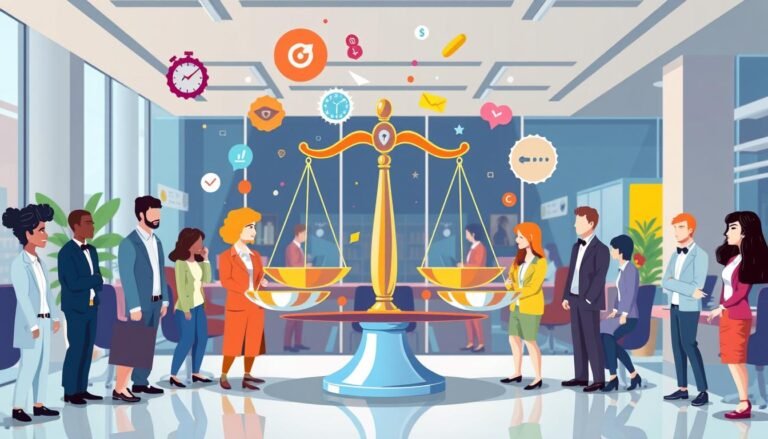How Intrinsic Motivation Transforms Employee Performance
Ever wondered why some employees excel while others struggle? The answer might be intrinsic motivation. This drive makes people work hard not for rewards, but for the joy of doing it.
Intrinsic motivation is key to better employee performance. It sparks creativity and innovation. When employees are motivated from within, they dive deep into their work, full of passion.
Studies show that motivated employees go beyond their job. They come up with new ideas, solve tough problems, and do great work. But how does this internal drive boost performance? Let’s explore the world of self-determination and its impact on work.
Key Takeaways
- Intrinsic motivation leads to increased innovation and creativity
- Self-driven employees show stronger loyalty and job satisfaction
- Internal drive improves work quality and productivity
- Intrinsically motivated staff manage stress more effectively
- Understanding personal motivators is crucial for fostering intrinsic motivation
- Managers play a vital role in cultivating intrinsic motivation
Understanding Intrinsic Motivation in the Workplace
Intrinsic motivation is about doing things for personal reasons, not just for rewards. It’s key in the workplace. It makes employees work better and feel happier.
Defining Intrinsic Motivation
Intrinsic motivation is when people do things because they enjoy it. At work, it means doing tasks because you want to, not just because you have to. It’s about reaching your best self.
The Psychology Behind Self-Driven Behavior
Self-determination theory says people are motivated when they feel they can do things well, connect with others, and have freedom. These needs drive employees to grow, learn, and make a difference at work.
Contrasting Intrinsic and Extrinsic Motivation
Intrinsic motivation comes from inside, while extrinsic motivation comes from outside rewards or punishments. Studies show that too many outside rewards can hurt internal motivation. A mix of both is usually best for keeping employees motivated.
| Intrinsic Motivation | Extrinsic Motivation |
|---|---|
| Internal rewards | External rewards/punishments |
| Promotes autonomy | Can reduce self-determination |
| Enhances creativity | May limit innovative thinking |
| Leads to job satisfaction | Can create dependency on rewards |
Knowing the difference helps managers create better work places. Places where people are motivated to do their best and grow.
The Three Pillars of Intrinsic Motivation
Intrinsic motivation comes from within, driven by personal growth and satisfaction. Daniel Pink’s book “Drive” explains three main pillars: autonomy, mastery, and purpose. These pillars are the base of this powerful motivator.
Autonomy lets employees control their work and schedule. Research shows that giving people this freedom boosts motivation more than just higher pay. It encourages creativity and improves overall happiness.
Mastery is about improving skills and competence. When tasks are challenging but achievable, employees get into a flow state. This state increases productivity and job happiness.
Purpose links work to a bigger meaning. Companies that aim for more than just profit have a positive effect on their community and workers. When personal values align with company goals, motivation lasts longer.
| Pillar | Impact on Motivation | Workplace Application |
|---|---|---|
| Autonomy | Increases creativity and well-being | Flexible work schedules and environments |
| Mastery | Enhances productivity and satisfaction | Challenging yet achievable tasks |
| Purpose | Fuels long-term motivation | Clear communication of company mission |
By focusing on these pillars, companies can create a better work environment. This environment boosts intrinsic motivation, leading to better performance and motivation among employees.
The Impact of Intrinsic Motivation on Employee Engagement
Intrinsic motivation is key to employee engagement. It boosts performance and creates a positive work place. When employees are driven from within, they feel more satisfied and committed to their jobs.
Increased Job Satisfaction and Commitment
Research shows that motivated employees are happier at work. This drive gives them a sense of purpose and fulfillment. A study of 349 city employees found a strong link between motivation and engagement.
Enhanced Creativity and Innovation
Curiosity fuels creativity and innovation. Employees with passion are more likely to come up with new ideas. This leads to innovative solutions and keeps companies ahead in the market.
Improved Work Quality and Productivity
Self-motivated people do better at work. A big study with 39,000 participants showed that motivated employees perform better and stay motivated longer.
| Aspect | Impact of Intrinsic Motivation |
|---|---|
| Job Satisfaction | High positive correlation |
| Creativity | Increased innovation and problem-solving |
| Productivity | Consistent high performance |
| Work Quality | Superior output and attention to detail |
By encouraging intrinsic motivation, companies can build a more engaged and productive team. This team will be more innovative and focused on quality work.
Fostering Autonomy: A Key Driver of Intrinsic Motivation
Autonomy is key to boosting intrinsic motivation. It meets our psychological needs and drives self-driven behavior. When managers let employees make choices, it sparks growth and creativity.
Studies show that giving autonomy leads to better results and happiness. This is especially true for those learning new languages or English. They do well when they control their learning space.
Good managers see themselves as resources, not controllers. They check in with employees but don’t watch them all the time. This creates a supportive place where everyone’s input is valued.
“Autonomy is not just about being independent. It’s about feeling empowered to make choices that match your values and goals.”
To boost autonomy and motivation, managers can:
- Give chances for self-direction
- Encourage creative problem-solving
- Offer flexible work hours when it’s possible
- Involve employees in decision-making
By using these methods, companies can unlock their employees’ motivation. This leads to happier workers, better productivity, and more innovation.
| Autonomy Support | Impact on Intrinsic Motivation |
|---|---|
| Choice in work tasks | Increased engagement and creativity |
| Influence on decisions | Enhanced sense of ownership and commitment |
| Flexible work arrangements | Improved work-life balance and job satisfaction |
| Self-directed learning opportunities | Accelerated personal growth and skill development |
Mastery and Skill Development: Cultivating Internal Drive
Mastery and skill development are key to boosting employee motivation and self-actualization. By encouraging ongoing learning, companies can unlock their team’s full potential. This leads to better performance and job satisfaction.
The Role of Continuous Learning
Continuous learning satisfies employees’ natural curiosity and drive for improvement. Research shows that those who are intrinsically motivated are more autonomous and persistent. This leads to higher job satisfaction and productivity.
Setting Challenging Yet Achievable Goals
Setting clear goals is essential for keeping employees motivated. By setting specific, measurable targets, workers can see their progress. This boosts their sense of accomplishment and engagement.
Providing Opportunities for Growth and Development
Companies that offer growth opportunities foster intrinsic motivation. By giving employees autonomy and purpose, they create a team driven by internal satisfaction. This not only increases productivity but also boosts creativity and innovation.
| Intrinsic Motivation Factors | Impact on Skill Development |
|---|---|
| Autonomy | Increases engagement and reduces resistance |
| Competence | Drives desire to improve and master new skills |
| Relatedness | Enhances motivation through social connections |
By focusing on these elements, companies can build a culture of continuous growth. This leads to a more motivated and productive team.
Connection and Purpose: Aligning Personal Values with Organizational Goals
When personal values match company goals, it creates a strong bond. This bond boosts motivation from within. It makes work feel meaningful and connected to personal dreams.
Studies reveal that when goals align, everyone wins. Workers feel happier and more committed. Companies see better teamwork and results. This balance meets basic psychological needs, boosting well-being and productivity.
“When employees’ personal values align with corporate purpose, they bring their whole self to work, leading to deep personal commitment.” – Center for Creative Leadership
Companies like TCS and Mahindra Group show how it works. TCS links new employees with nonprofits, showing value beyond money. Mahindra’s RISE philosophy unites diverse groups under a shared purpose, aligning with employee values.
| Benefits of Alignment | For Individuals | For Organizations |
|---|---|---|
| Sense of Purpose | Increased motivation | Improved performance |
| Career Growth | Personal satisfaction | Enhanced teamwork |
| Self-Determination | Work-life balance | Better decision-making |
To achieve this alignment, companies must share their vision clearly. They should link personal goals to company aims and offer flexibility. This way, they create a space where motivation grows, leading to a more engaged and happy team.
The Manager’s Role in Nurturing Intrinsic Motivation
Managers are key in helping employees grow and stay motivated. They create an environment that sparks personal growth and boosts performance.
Creating a Supportive Work Environment
A supportive workplace is essential for motivation. Research shows that feeling in control, competent, and connected boosts motivation. Managers should focus on the non-monetary aspects of a job to encourage internal drive.
Effective Communication and Feedback Strategies
Good communication is crucial for motivation. Regular meetings build trust and help understand what drives each team member. Asking open-ended questions during these meetings can help managers tailor support.
Recognizing and Rewarding Intrinsically Motivated Behavior
While rewards can sometimes backfire, recognizing self-driven efforts is key. Managers should celebrate personal growth and achievements that match company goals. This can lead to a 4.4% profit increase when goals align.
| Management Practice | Impact on Intrinsic Motivation |
|---|---|
| Clear objectives | Increased motivation |
| Staff autonomy | Higher intrinsic drive |
| Development opportunities | Positive impact on motivation |
| Rewards fairness | Enhanced intrinsic motivation |
Overcoming Challenges in Implementing Intrinsic Motivation Strategies
Boosting internal drive in the workplace isn’t always easy. Managers often struggle to balance extrinsic and intrinsic motivators. A 2014 Deloitte study found that 87% of Americans felt they couldn’t give their full potential at work because of a lack of passion. This shows the need for good strategies to tap into employees’ self-determination.
One big challenge is dealing with individual differences in psychological needs. What motivates one employee might not motivate another. To overcome this, companies like Google let engineers spend 20% of their time on projects they choose. This has boosted creativity and team performance.
Keeping motivation up over time is another challenge. It’s important to regularly check how motivation strategies are working and ask for employee feedback. By supporting feelings of competence, autonomy, and relatedness, managers can help intrinsic motivation. Studies show that giving employees more autonomy improves their psychological health at work.
Source Links
- Intrinsic motivation: The missing piece in changing employee behavior – IMD business school for management and leadership courses
- Understanding the Power of Intrinsic Motivation
- What Is Intrinsic Motivation and How Does It Work? [2024] • Asana
- What is Intrinsic Motivation and How Does It Work? (Examples)
- The Three Pillars of Motivation
- Motivation – Pink (Three Elements of Intrinsic Motivation)
- Impact of Intrinsic and Extrinsic Motivation on Work Engagement: A Cross-Sectional Study of Nurses Working in Long-Term Care Facilities
- Understanding the Impact of Intrinsic Motivation
- The effect of motivation on employee engagement in public sectors: in the case of North Wollo zone – Journal of Innovation and Entrepreneurship
- Microsoft Word – Ryan and Deci CEP Pre-Print.docx
- Fostering intrinsic motivation | Ellevation
- On what motivates us: a detailed review of intrinsic v. extrinsic motivation
- The role of motivation in skills development
- Intrinsic Motivation: How Internal Rewards Drive Behavior
- Aligning Individual Goals With Organizational Goals: A Winning Combination | ITD World
- Align employee and organizational purpose to drive belonging and commitment
- Supportive management practice and intrinsic motivation go together in the public service
- Nurturing Intrinsic Motivation in the Workplace
- How to Support and Nurture the Intrinsic Motivation of Others
- How to Increase Intrinsic Motivation (According to Science)
- Intrinsic Motivation In The Workplace: 8 Examples To Improve Your Company







